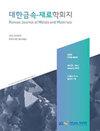API X70电阻焊接钢管不同热输入和缝后退火温度下组织与冲击韧性关系的研究
IF 1.1
4区 材料科学
Q4 MATERIALS SCIENCE, MULTIDISCIPLINARY
引用次数: 0
摘要
研究了热输入和束后退火(PSA)温度对API X70电阻焊接钢管组织和冲击韧性的影响。在低、中、高热输入条件下制作了管道ERW焊缝,然后在950℃下进行PSA工艺。在不考虑热输入的情况下,API X70钢管表现出良好的可焊性,导致类似的微观结构因素,即金属流动角(~70o)、焊线宽度(~22μm)和铁素体晶粒尺寸(~4.4μm)。尽管在接合线上观察到了已知会损害冲击韧性的富(Mn,Si)氧化物渗透剂,但在所有ERW焊缝中,面积分数估计低至0.011%。冲击韧性不受这些穿透剂的影响,因为它们的分数很小,导致在-20℃下发生韧性断裂。然而,不同的PSA温度(870、950和1040℃)导致焊缝的晶粒尺寸不同。1040℃退火的ERW焊缝(PSA1040)在结合线附近表现出最大的铁素体晶粒尺寸,而870℃退火的焊缝(PSA870)则表现出最小的晶粒尺寸。尽管PSA870具有最小的晶粒尺寸,但其冲击韧性值最低,在–20℃时表现出脆性断裂。观察到残余应力的差异不能通过钻孔方法从宏观上检测到。核平均取向差(KAM)图表明,在PSA870的结合线附近观察到最高水平的残余应力,如高密度位错所证明的。这项研究提供了有指导意义的结果,表明残余应力对ERW焊缝冲击韧性的影响明显大于晶粒细化效应。本文章由计算机程序翻译,如有差异,请以英文原文为准。
A Study on the Relationship between Microstructure and Impact Toughness with Different Heat Inputs and Post-Seam Annealing Temperatures in API X70 Electric Resistance Welded Steel Pipe
In this study, the influence of heat input and post-seam annealing (PSA) temperature on the microstructure and impact toughness of electric resistance welded (ERWed) API X70 steel pipe was investigated. The ERW seam welds of pipes were fabricated with low, moderate, and high heat inputs, and followed by the PSA process at 950 ℃. Regardless of heat input, the API X70 steel pipe exhibited good weldability, resulting in similar microstructure factors, i.e., metal flow angle (~70o), bondline width (~22 μm), and ferrite grain size (~4.4 μm). Although (Mn, Si)-rich oxide penetrators which are known to impair impact toughness were observed at the bondline, the area fraction was estimated to be as low as 0.011% in all the ERW seam welds. The impact toughness was not affected by these penetrators because of their minimal fraction, leading to ductile fracture at -20 ℃. However, different PSA temperatures (870, 950, and 1040 ℃) resulted in the different grain sizes of the seam welds. The ERW seam weld annealed at 1040 ℃ (PSA1040) exhibited the largest ferrite grain size near the bondline, whilst the smallest grain size was found in the ERW weld annealed at 870 ℃ (PSA870). In spite of having the smallest grain size, PSA870 exhibited the lowest impact toughness value, showing brittle fracture at –20 ℃. It was observed that the difference in residual stresses was not macroscopically detectable by the hole drilling method. The kernel average misorientation (KAM) maps indicated that the highest level of residual stress was observed near the bondline of PSA870, as evidenced by a high density of dislocations. This study provides instructive results, indicating that the impact toughness of ERW seam welds are significantly more affected by residual stresses than by the grain refinement effect.
求助全文
通过发布文献求助,成功后即可免费获取论文全文。
去求助
来源期刊

Korean Journal of Metals and Materials
MATERIALS SCIENCE, MULTIDISCIPLINARY-METALLURGY & METALLURGICAL ENGINEERING
CiteScore
1.80
自引率
58.30%
发文量
100
审稿时长
4-8 weeks
期刊介绍:
The Korean Journal of Metals and Materials is a representative Korean-language journal of the Korean Institute of Metals and Materials (KIM); it publishes domestic and foreign academic papers related to metals and materials, in abroad range of fields from metals and materials to nano-materials, biomaterials, functional materials, energy materials, and new materials, and its official ISO designation is Korean J. Met. Mater.
 求助内容:
求助内容: 应助结果提醒方式:
应助结果提醒方式:


